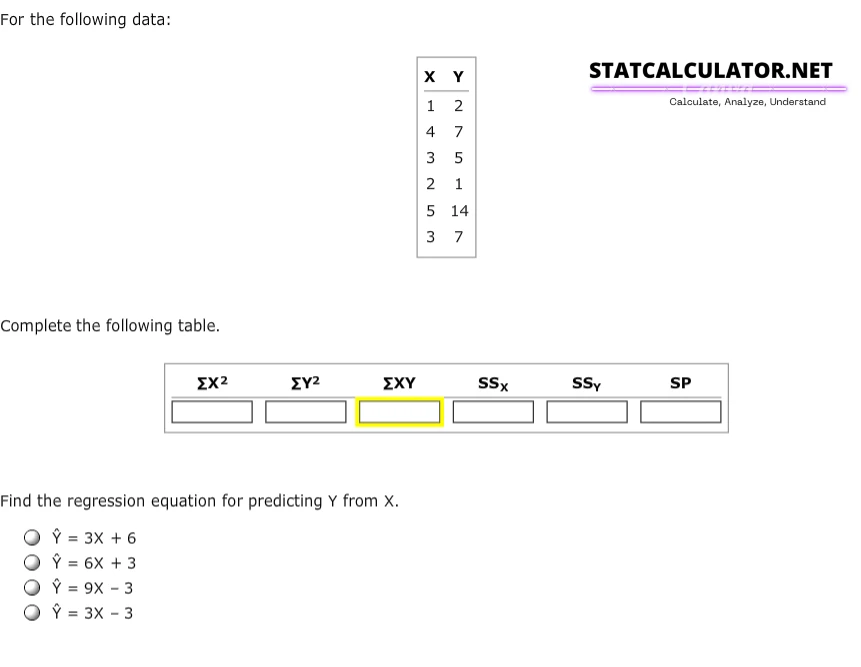Introduction
Linear regression might sound intimidating, but it’s a powerful tool for understanding data and making predictions. Imagine it as drawing a straight line through a scatter of points on a graph. We’ve made it even easier with our Linear Regression Calculator, which we’ll use throughout this guide.
Regression Calculator
Summary :
| Slope: | |
|---|---|
| Y-intercept: | |
| regression equation: |
Step by step solution :
Calculation table :
| \(\mathrm{X}\) | \(\mathrm{Y}\) | \(\mathrm{X^{2}}\) | \(\mathrm{Y^{2}}\) | \(\mathrm{XY}\) |
|---|
Mean of X :
Mean of Y :
Sum of squares for x :
Sum of squares for y :
Sum of cross products :
Slope :
Intercept :
Regression equation
The regression equation is :
Scatterplot with Regression Line :
Related Calculators
Understanding Linear Regression
Linear regression helps us spot trends and forecast future outcomes. It’s like fitting a straight line to a set of data points, allowing us to make predictions based on that line. You might hear terms like “linear regression formula” or “linear regression equation,” which essentially refer to the math behind this process.
Data Setup Simplified
Before we dive into the math, let’s talk about data. Good data is essential for accurate linear regression. Think of it as the foundation of your analysis. You need organized, relevant data to get meaningful results. We won’t get into complex details here; just know that clean data is key.
The Heart of Regression: The Formula
The linear regression formula \( \mathrm{y = a + bx}\) or \( \mathrm{\hat{y} = a +bx} \) is the core of this method. It’s like the recipe for understanding relationships in your data. In this equation, y or \(\mathrm{\hat{y}}\) is what we’re trying to predict, x is the factor we’re considering, b represents the slope of the line, and a is where the line starts (intercept).
Calculating the Slope (b)
The slope, represented by ‘b,’ tells us how steep our line is. Calculating it might sound intimidating, but don’t worry. With our Linear Regression Calculator, it’s as simple as plugging in your data and hitting a button. We’ll walk you through it step by step, and we’ll even show you some visuals to make it crystal clear.
The formula for the slope is \( \mathrm{\frac{SS_{xy}}{SS_{xx}}} \)
Finding the Intercept (b)
Now, the intercept, ‘a,’ is where our line crosses the y-axis. It’s another crucial part of the puzzle. Using our Linear Regression Calculator, we’ll guide you through the process of finding it. No complex math; just straightforward instructions with visuals.
The formula for the slope is \( \mathrm{ \bar{y} – b \times \bar{x} } \)
Visualizing Results
Seeing is believing. That’s why we’ll show you how to create a scatterplot with the regression line using our calculator. It’s like having a visual representation of your data and the relationship you’ve uncovered. Trust us; this part makes things much more understandable.
What It All Means
Alright, we’ve got our regression equation. But what does it all mean? In this section, we’ll explain how to interpret the results in everyday language. We’ll even throw in some relatable examples so you can grasp the practical significance. And don’t worry if you’ve heard about a “least squares calculator” – we’ll touch on that too, in the context of assessing accuracy.
Conclusion
In a nutshell, linear regression doesn’t have to be as complex as it may seem. We’ve walked you through the process, step by step, using our handy Linear Regression Calculator. You can now confidently use this tool for your data analysis and predictions.
Call to Action
Ready to try it out for yourself? Click here to use our Linear Regression Calculator. Have questions or insights? We’d love to hear from you! Leave a comment or share your experiences. And if you found this guide helpful, why not share it with your friends on social media?
Example :

How to solve above question using our Linear Regression Calculator.
- Enter your x and y values in the calculator
- Press calculate button
- The Calculator will give all the required Value ask in the above question
- Note : SP is nothing but Sum of cross products ( \(\mathrm{S_{xy} }\) )
